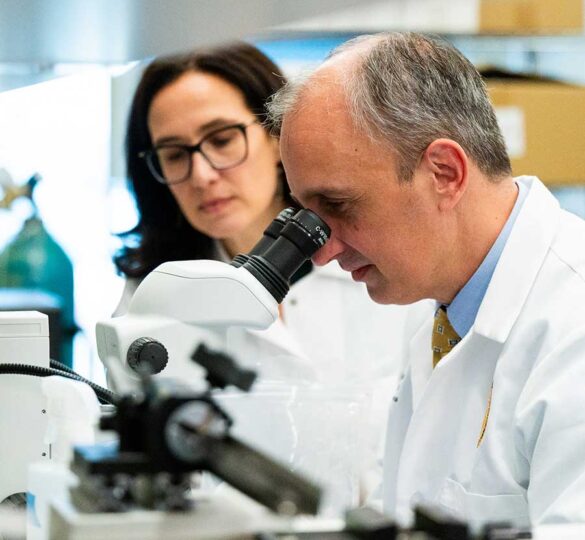Exploring the Latest Breakthroughs in Glaucoma Research
The future of glaucoma research holds immense promise. With each discovery we move closer to achieving more effective treatments and, ultimately, a cure for glaucoma.

According to the National Library of Medicine, glaucoma affects over 70 million people worldwide, with nearly 10% of them developing bilateral blindness. Thanks to the ongoing diligence of researchers and clinicians, glaucoma research is advancing rapidly, offering hope for better diagnostic tools, more effective treatments, and potential cures.
The collective commitment to mitigating the impact of this debilitating eye disease, which remains a leading cause of irreversible blindness worldwide, drives this relentless pursuit of knowledge and innovation.
While there are exciting and promising breakthroughs in glaucoma treatments, it’s important to approach information cautiously. For instance, you might find claims online about treatments promising to cure glaucoma. However, despite significant progress in research, there is currently no cure for this condition.
Some of these unproven treatments can be dangerous and pose severe risks to your eyesight. Therefore, it’s crucial to rely on credible sources for information. Continue reading to learn more about the latest advancements and global collaborations making significant strides in combating this debilitating disease.
Overall Developments in Glaucoma Research
Genetic Research
Genetic research has provided valuable insights into the hereditary factors contributing to glaucoma. Scientists have identified several genes associated with an increased risk of developing glaucoma. For instance, mutations in the MYOC and OPTN genes link to juvenile and adult-onset open-angle glaucoma. Ongoing research aims to uncover more genetic markers, which could lead to early detection and personalized treatment plans.
Advances in Diagnostic Techniques
Early diagnosis is crucial for managing glaucoma and preventing vision loss. Recent advancements in diagnostic technologies have significantly improved the accuracy and reliability of glaucoma detection. These include:
- Optical Coherence Tomography (OCT): Provides non-invasive high-resolution cross-sectional retina images.
- Visual Field Testing: Measures peripheral vision and detects changes over time.
Innovative Treatment Options
While there is no cure for glaucoma, various treatment options aim to lower intraocular pressure (IOP) and prevent further damage to the optic nerve. Current research focuses on developing new medications, surgical techniques, and potential regenerative therapies.
- Medications: Researchers are exploring novel drug delivery systems, such as sustained-release implants, to improve medication adherence and effectiveness.
- Minimally Invasive Glaucoma Surgery (MIGS): New surgical devices and techniques, such as the Hydrus Microstent and XEN® Gel Stent, offer less invasive alternatives to traditional surgery.
Global Collaborative Efforts
Glaucoma research benefits significantly from global collaboration among scientists, healthcare providers, and patient advocacy groups. International initiatives, such as the World Glaucoma Association (WGA) and the International Glaucoma Association (IGA), promote research, education, and awareness on a global scale.
Specific Developments in Glaucoma Treatment Options and Understanding
Recent advances in glaucoma research have shown significant progress in both treatment options and our understanding of the disease:
- iDose® TR Implant: The FDA recently approved the iDose® TR, a first-of-its-kind implant that delivers continuous drug therapy for up to three years. The implant, which releases travoprost intracameral, helps manage IOP in glaucoma patients, offering a long-term solution compared to traditional eye drops.
- Genome-Wide Association Studies (GWAS): A major GWAS identified 44 new gene loci associated with glaucoma and confirmed 83 previously known loci. This extensive study, which included a diverse population, could improve genetic testing and targeted treatments.
- Gene Therapy: Researchers at Trinity College Dublin have developed a groundbreaking gene therapy targeting the enzyme matrix metalloproteinase-3 (MMP-3). This innovative approach holds great promise in treating glaucoma by protecting and regenerating optic nerve cells, offering a hopeful glimpse into potential clinical applications.
- New Medications: The FDA’s recent approval of Omlonti (omidenepag isopropyl), a new eye drop medication that enhances aqueous humor drainage through unique pharmacological actions, is a significant step forward. This treatment, backed by the FDA’s rigorous approval process, provides another safe and effective option for managing IOP in patients with primary open-angle glaucoma.
- Vision Restoration Initiatives: The Catalyst for a Cure Vision Restoration Initiative focuses on regenerating the optic nerve’s retinal ganglion cells and axons. This paradigm shift from merely managing IOP to repairing optic nerve damage offers hope for reversing vision loss in glaucoma patients.
These advancements highlight a multi-faceted approach to glaucoma treatment, from innovative drug delivery systems and genetic research to cutting-edge gene therapies and regenerative medicine, significantly improving prospects for those affected by this disease.
Future Directions in Glaucoma Research
The future of glaucoma research is promising, with several key areas of focus:
- Artificial Intelligence: Researchers are developing AI algorithms to improve early detection and treatment personalization.
- Gene Therapy: Ongoing trials are investigating the potential of gene therapy to deliver genes that slow or halt glaucoma progression.
- Stem Cell Therapy: Researchers are exploring stem cell therapy to regenerate damaged optic nerve cells.
Help Us Provide Hope
The future of glaucoma research holds immense promise. With each discovery and technological breakthrough, we move closer to achieving more effective treatments and, ultimately, a cure for glaucoma. Stay informed about these exciting developments, representing hope for those battling this condition.
The tireless work of researchers continues to lead to a better understanding of glaucoma every day. As a result, there’s great hope for new and improved treatments, including superior drug delivery methods, laser treatments, and less invasive surgical techniques. You can help make that happen! Your support can help dedicated researchers continue to discover cures for glaucoma. Your donations also give hope to those living with glaucoma and accelerate our search for a cure.
Reviewed for scientific accuracy by Derek Welsbie, MD, PhD. Posted on September 19, 2024.

Derek Welsbie, MD, PhD
Derek Welsbie, MD, PhD is an Associate Professor of Ophthalmology at the Shiley Eye Institute, University of California, San Diego and a principal investigator in the Catalyst for a Cure Vision Restoration Initiative.